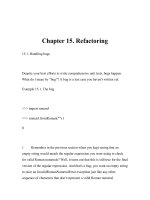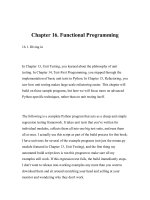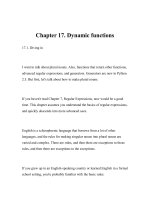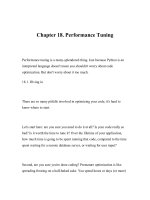Dive Into Python-Chapter 13. Unit Testing
Bạn đang xem bản rút gọn của tài liệu. Xem và tải ngay bản đầy đủ của tài liệu tại đây (142.79 KB, 19 trang )
Chapter 13. Unit Testing
13.1. Introduction to Roman numerals
In previous chapters, you “dived in” by immediately looking at code and
trying to understand it as quickly as possible. Now that you have some
Python under your belt, you're going to step back and look at the steps that
happen before the code gets written.
In the next few chapters, you're going to write, debug, and optimize a set of
utility functions to convert to and from Roman numerals. You saw the
mechanics of constructing and validating Roman numerals in Section 7.3,
“Case Study: Roman Numerals”, but now let's step back and consider what
it would take to expand that into a two-way utility.
The rules for Roman numerals lead to a number of interesting observations:
1. There is only one correct way to represent a particular number as
Roman numerals.
2. The converse is also true: if a string of characters is a valid Roman
numeral, it represents only one number (i.e. it can only be read one way).
3. There is a limited range of numbers that can be expressed as Roman
numerals, specifically 1 through 3999. (The Romans did have several ways
of expressing larger numbers, for instance by having a bar over a numeral to
represent that its normal value should be multiplied by 1000, but you're not
going to deal with that. For the purposes of this chapter, let's stipulate that
Roman numerals go from 1 to 3999.)
4. There is no way to represent 0 in Roman numerals. (Amazingly, the
ancient Romans had no concept of 0 as a number. Numbers were for
counting things you had; how can you count what you don't have?)
5. There is no way to represent negative numbers in Roman numerals.
6. There is no way to represent fractions or non-integer numbers in Roman
numerals.
Given all of this, what would you expect out of a set of functions to convert
to and from Roman numerals?
roman.py requirements
1. toRoman should return the Roman numeral representation for all
integers 1 to 3999.
2. toRoman should fail when given an integer outside the range 1 to 3999.
3. toRoman should fail when given a non-integer number.
4. fromRoman should take a valid Roman numeral and return the number
that it represents.
5. fromRoman should fail when given an invalid Roman numeral.
6. If you take a number, convert it to Roman numerals, then convert that
back to a number, you should end up with the number you started with. So
fromRoman(toRoman(n)) == n for all n in 1..3999.
7. toRoman should always return a Roman numeral using uppercase
letters.
8. fromRoman should only accept uppercase Roman numerals (i.e. it
should fail when given lowercase input).
Further reading
* This site has more on Roman numerals, including a fascinating history
of how Romans and other civilizations really used them (short answer:
haphazardly and inconsistently).
13.2. Diving in
Now that you've completely defined the behavior you expect from your
conversion functions, you're going to do something a little unexpected:
you're going to write a test suite that puts these functions through their paces
and makes sure that they behave the way you want them to. You read that
right: you're going to write code that tests code that you haven't written yet.
This is called unit testing, since the set of two conversion functions can be
written and tested as a unit, separate from any larger program they may
become part of later. Python has a framework for unit testing, the
appropriately-named unittest module.
Note
unittest is included with Python 2.1 and later. Python 2.0 users can
download it from pyunit.sourceforge.net.
Unit testing is an important part of an overall testing-centric development
strategy. If you write unit tests, it is important to write them early (preferably
before writing the code that they test), and to keep them updated as code and
requirements change. Unit testing is not a replacement for higher-level
functional or system testing, but it is important in all phases of development:
* Before writing code, it forces you to detail your requirements in a useful
fashion.
* While writing code, it keeps you from over-coding. When all the test
cases pass, the function is complete.
* When refactoring code, it assures you that the new version behaves the
same way as the old version.
* When maintaining code, it helps you cover your ass when someone
comes screaming that your latest change broke their old code. (“But sir, all
the unit tests passed when I checked it in...”)
* When writing code in a team, it increases confidence that the code
you're about to commit isn't going to break other peoples' code, because you
can run their unittests first. (I've seen this sort of thing in code sprints. A
team breaks up the assignment, everybody takes the specs for their task,
writes unit tests for it, then shares their unit tests with the rest of the team.
That way, nobody goes off too far into developing code that won't play well
with others.)
13.3. Introducing romantest.py
This is the complete test suite for your Roman numeral conversion
functions, which are yet to be written but will eventually be in roman.py. It
is not immediately obvious how it all fits together; none of these classes or
methods reference any of the others. There are good reasons for this, as
you'll see shortly.
Example 13.1. romantest.py
If you have not already done so, you can download this and other examples
used in this book.
"""Unit test for roman.py"""
import roman
import unittest
class KnownValues(unittest.TestCase):
knownValues = ( (1, 'I'),
(2, 'II'),
(3, 'III'),
(4, 'IV'),
(5, 'V'),
(6, 'VI'),
(7, 'VII'),
(8, 'VIII'),
(9, 'IX'),
(10, 'X'),
(50, 'L'),
(100, 'C'),
(500, 'D'),
(1000, 'M'),
(31, 'XXXI'),
(148, 'CXLVIII'),
(294, 'CCXCIV'),
(312, 'CCCXII'),
(421, 'CDXXI'),
(528, 'DXXVIII'),
(621, 'DCXXI'),
(782, 'DCCLXXXII'),
(870, 'DCCCLXX'),
(941, 'CMXLI'),
(1043, 'MXLIII'),
(1110, 'MCX'),
(1226, 'MCCXXVI'),
(1301, 'MCCCI'),
(1485, 'MCDLXXXV'),
(1509, 'MDIX'),
(1607, 'MDCVII'),
(1754, 'MDCCLIV'),
(1832, 'MDCCCXXXII'),
(1993, 'MCMXCIII'),
(2074, 'MMLXXIV'),
(2152, 'MMCLII'),
(2212, 'MMCCXII'),
(2343, 'MMCCCXLIII'),
(2499, 'MMCDXCIX'),
(2574, 'MMDLXXIV'),
(2646, 'MMDCXLVI'),
(2723, 'MMDCCXXIII'),
(2892, 'MMDCCCXCII'),
(2975, 'MMCMLXXV'),
(3051, 'MMMLI'),
(3185, 'MMMCLXXXV'),
(3250, 'MMMCCL'),
(3313, 'MMMCCCXIII'),
(3408, 'MMMCDVIII'),
(3501, 'MMMDI'),
(3610, 'MMMDCX'),
(3743, 'MMMDCCXLIII'),
(3844, 'MMMDCCCXLIV'),
(3888, 'MMMDCCCLXXXVIII'),
(3940, 'MMMCMXL'),
(3999, 'MMMCMXCIX'))
def testToRomanKnownValues(self):
"""toRoman should give known result with known input"""
for integer, numeral in self.knownValues:
result = roman.toRoman(integer)
self.assertEqual(numeral, result)
def testFromRomanKnownValues(self):
"""fromRoman should give known result with known input"""
for integer, numeral in self.knownValues:
result = roman.fromRoman(numeral)
self.assertEqual(integer, result)
class ToRomanBadInput(unittest.TestCase):
def testTooLarge(self):
"""toRoman should fail with large input"""
self.assertRaises(roman.OutOfRangeError, roman.toRoman, 4000)
def testZero(self):
"""toRoman should fail with 0 input"""
self.assertRaises(roman.OutOfRangeError, roman.toRoman, 0)
def testNegative(self):
"""toRoman should fail with negative input"""
self.assertRaises(roman.OutOfRangeError, roman.toRoman, -1)
def testNonInteger(self):
"""toRoman should fail with non-integer input"""
self.assertRaises(roman.NotIntegerError, roman.toRoman, 0.5)
class FromRomanBadInput(unittest.TestCase):
def testTooManyRepeatedNumerals(self):
"""fromRoman should fail with too many repeated numerals"""
for s in ('MMMM', 'DD', 'CCCC', 'LL', 'XXXX', 'VV', 'IIII'):
self.assertRaises(roman.InvalidRomanNumeralError,
roman.fromRoman, s)
def testRepeatedPairs(self):
"""fromRoman should fail with repeated pairs of numerals"""
for s in ('CMCM', 'CDCD', 'XCXC', 'XLXL', 'IXIX', 'IVIV'):
self.assertRaises(roman.InvalidRomanNumeralError,
roman.fromRoman, s)
def testMalformedAntecedent(self):
"""fromRoman should fail with malformed antecedents"""
for s in ('IIMXCC', 'VX', 'DCM', 'CMM', 'IXIV',









